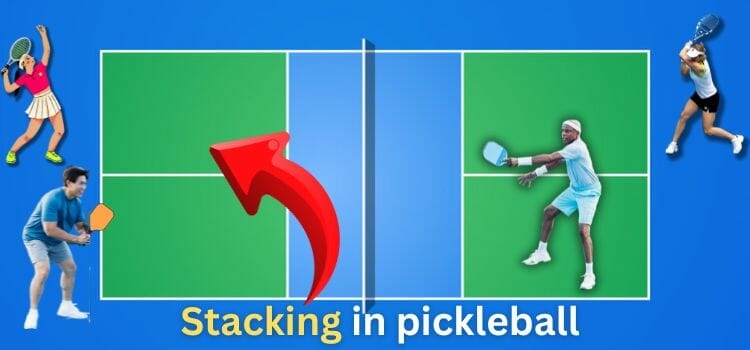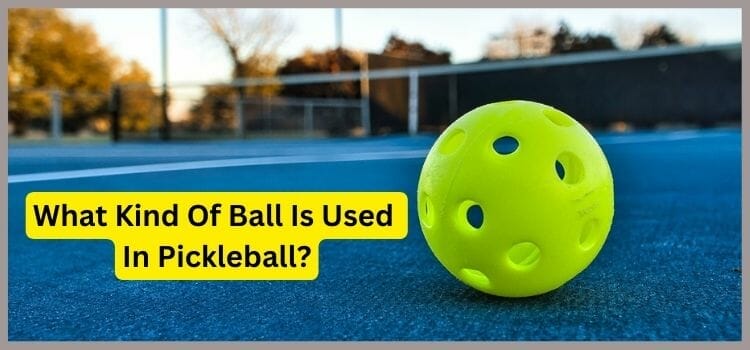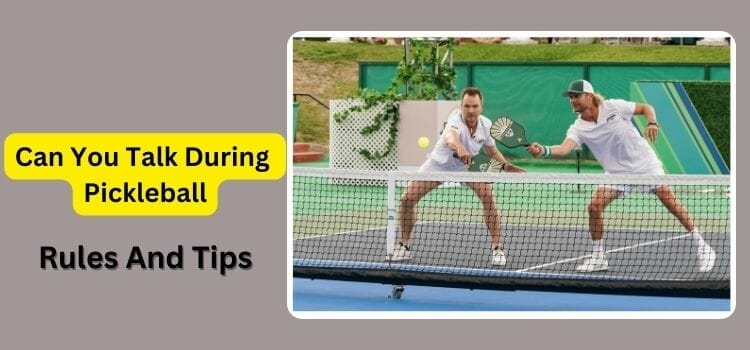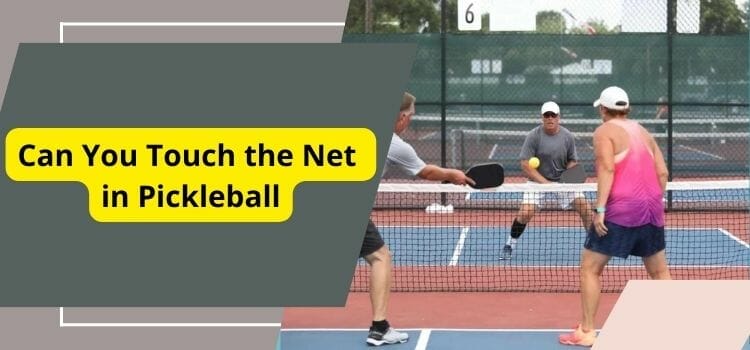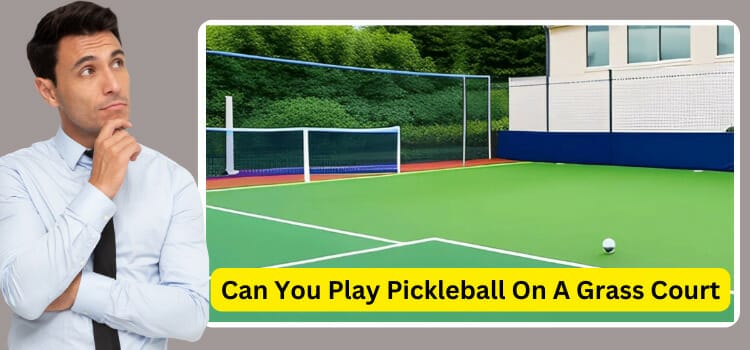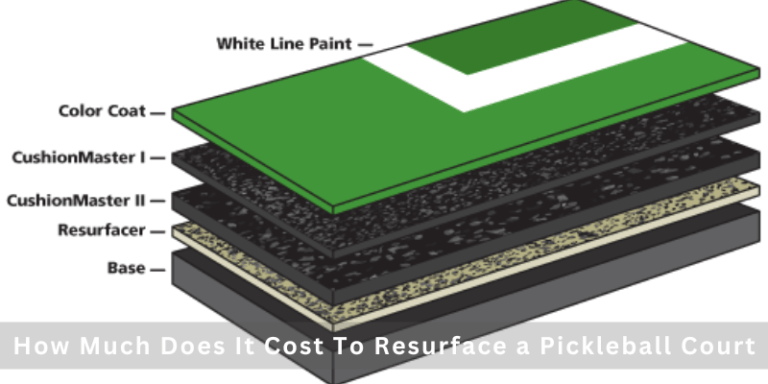What Is the Standard Size of a Pickleball Court | Best Guide
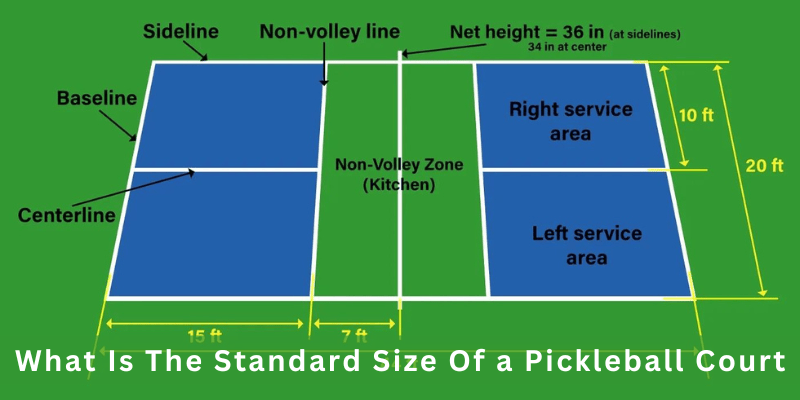
Elevate your pickleball skills by understanding the significance of court size – take your game to the next level.
The standard size of a pickleball court is 20 feet wide by 44 feet long for both singles and doubles play. The court is divided in half by a 34-inch-high net. The non-volley zone or kitchen is a seven-foot area on each side of the net.
As a newbie to pickleball, I didn’t realize the importance of court size. One day, while playing on a smaller court, I found it difficult to hit the ball within the boundaries.
After some research, I learned that the standard size of a pickleball court is 20 feet wide and 44 feet long. Soon, I realized that the standard court size was crucial for proper gameplay and fair competition.
In this article, we’ll dive deep into the question “What is the standard size of a pickleball court?” and explore everything you need to know.
Let’s dive into it!
What is the Standard Size of a Pickleball Court? – Complete Guide
The court’s dimensions are specifically designed to promote fast-paced, dynamic gameplay while still allowing players to cover the court effectively.
These dimensions are used in official competitions and are considered the standard size for pickleball courts.
The standard size of a pickleball court is 20 feet wide by 44 feet long, or approximately 6.10 meters by 13.41 meters.
The court is rectangular and divided in half by a net that is 36 inches (0.914 meters) high at the edges and 34 inches (0.864 meters) high in the center.
The court is marked with lines that create several areas. The baseline is the line at the back of the court, and the sideline is the line at the side of the court.
The service area is the area closest to the net on each side of the court, bounded by the service line and the sideline.
The non-volley zone, also known as the kitchen, is the area immediately in front of the net, bounded by the two sidelines and the non-volley line, which is 7 feet (2.13 meters) from the net.
The orientation of the court is such that the two service courts are diagonally opposite each other, with the center line bisecting both. This creates a left and right service court for each team to serve from.
Compared to other court sizes, a pickleball court is smaller than a tennis court, which is 27 feet wide by 78 feet long, or approximately 8.23 meters by 23.77 meters.
A pickleball court is also larger than a badminton court, which is 20 feet wide by 44 feet long, or approximately 6.10 meters by 13.41 meters, but has a different orientation and net height.
Overall, the standard size and specifications of a pickleball court are designed to create a balanced and fair playing field for players of all skill levels.
Description of the pickleball court’s lines and areas
A pickleball court is marked with several lines that define different areas of the court. Here’s a description of each of them:
1. Baseline
The baseline is the line at the back of the court, running parallel to the net.
2. Sideline
The sideline is the line at the side of the court, running perpendicular to the net.
3. Non-volley line
The non-volley line, also known as the kitchen line, is located 7 feet (2.13 meters) from the net and runs parallel to it.
Players are not allowed to hit the ball while standing in this area unless the ball bounces first.
4. Service line
The service line is located parallel to the net, dividing the court into two halves. It is located 15 feet (4.57 meters) from the net.
5. Centerline
The centerline runs perpendicular to the net and divides the court into two equal halves.
6. Service courts
The service courts are two diagonally opposite sections of the court that are defined by the service line, centerline, and sideline.
Each team serves from their respective service court, and the serve must land in the opposite service court.
7. Baseline area
The area between the baseline and the non-volley line.
8. Service area
The area between the service line and the net on each side of the court, bounded by the sideline and the centerline.
These lines and areas provide structure and organization to the game and allow players to understand the boundaries of the court and the rules of play.
Why is it Important to Know the Standard Size of a Pickleball Court?
Knowing the standard size of a pickleball court is important because it ensures fairness and consistency in gameplay, as well as safety for players.
Pickleball is a sport that is played on a court that is smaller than a tennis court, and the dimensions of the court have been standardized to ensure that players compete on a level playing field.
If the court is not the correct size, it can affect the way the game is played and may give an unfair advantage to one team or player. Playing on a court that is too small can increase the risk of injury to players.
By knowing the standard size of a pickleball court, players can ensure that they are playing the game as it was intended to be played and that they are doing so safely.
There are some other reasons as well, including:
- Playing on a court that adheres to the standard size ensures consistency in gameplay.
- Knowledge of the standard size is crucial for players to focus on improving their skills and strategies.
- Knowing the standard size of a pickleball court is essential to adhere to the rules and regulations of the game.
- Failure to comply with standard court size criteria in official tournaments and competitions can result in disqualification or penalties.
Factors that Affect Pickleball Court Size
There are several factors that can affect the size of a pickleball court:
1. Level of play
The size of a pickleball court can vary depending on the level of play. For recreational play, the court size is typically 20 feet wide by 44 feet long.
For competitive play, the court is slightly smaller, measuring 20 feet wide by 40 feet long.
2. Indoor or outdoor court
The dimensions of a pickleball court can be modified depending on whether it is being played indoors or outdoors.
Outdoor courts may need to be slightly larger to accommodate for wind and other weather conditions, while indoor courts may be smaller due to space constraints.
3. Surface material
The type of surface material used for the court can also affect its size. For example, if the court is made of a material that allows for more bounce, such as concrete or asphalt, it may need to be slightly larger to accommodate for the increased speed of the game.
On the other hand, if the court is made of a softer surface material, such as clay or synthetic turf, it may not need to be as large to accommodate for the slower pace of the game.
Difference between pickleball Singles and Doubles Courts
The dimensions of a singles pickleball court are the same as a doubles court, which is 20 feet wide and 44 feet long. The court is divided in half by a 34-inch-high net.
However, in singles play, only the area between the non-volley line and the baseline is used for serving and receiving, while in doubles play, the entire court is used.
Differences between pickleball singles and doubles courts
- The size of a pickleball court for singles and doubles play is the same: 20 feet wide by 44 feet long.
- The main difference between singles and doubles courts is the amount of playable area within the court.
- In doubles play, the court is wider due to the presence of the double’s sidelines, which adds an additional 2 feet of playable area on each side of the court.
- The presence of the doubles sidelines in doubles play means that players have a larger area to cover and must adjust their strategies accordingly.
- The court size is the same for singles and doubles play, but the playable area within the court differs, making doubles play more challenging in terms of court coverage.
Which type of court is more commonly used in pickleball
- Doubles courts are more commonly used than singles courts, as the majority of pickleball games are played in doubles format.
- However, singles play is becoming increasingly popular, and some courts are designed with both singles and doubles lines to accommodate both formats.
- If there are only two players, they can play singles on a standard pickleball court. If there are four players, they can play doubles on a standard pickleball court.
- Ultimately, the type of court used will depend on the preferences and needs of the players and the availability of court space.
Materials needed to build a Pickleball Court
Knowing the right materials for a pickleball court is crucial for a successful and enjoyable playing experience.
The court surface, perimeter fencing, and lighting are all important aspects to consider when building a pickleball court.
There are several types of surfaces to choose from, each with its own set of pros and cons.
For instance, asphalt is a popular choice for outdoor courts due to its durability and low cost, but it can also be hard on the feet and may require regular maintenance.
Other options include concrete, acrylic, and rubber, each with its own unique features.
When it comes to perimeter fencing and lighting, it is recommended to use materials that are durable, weather-resistant, and provide adequate visibility.
To build a pickleball court, you will need the following materials:
1. Surface Material
The surface material is the most important part of the pickleball court. Common surface materials include asphalt, concrete, and wood.
There are also specialized materials designed specifically for pickleball courts, such as cushioned surfaces.
2. Paint
You will need paint to mark the lines on the court. The paint should be suitable for outdoor use and able to withstand weather conditions.
3. Net
A pickleball net is essential for gameplay. You will need a net that is the appropriate height and length for a pickleball court.
4. Posts
Posts are used to hold up the net. They should be strong enough to withstand tension from the net.
5. Boundary Lines
You will need boundary lines to mark the court’s edges. These lines can be made of paint, tape, or other suitable materials.
6. Non-slip Surface
A non-slip surface is important for player safety. The surface material should provide good traction, especially when wet.
7. Lighting
If you plan to play pickleball at night, you will need adequate lighting. You can use floodlights or other types of outdoor lighting to illuminate the court.
8. Court Accessories
Optional accessories include scoreboards, ball holders, and benches for players.
The exact materials needed will depend on the size and type of court you want to build.
It is recommended to consult with a professional or expert in pickleball court construction to ensure that you have all the necessary materials for your specific project.
How to measure and set up a Pickleball Court?
There are several steps of setting up a pickleball court that are follows:
- Start by locating a flat, level area that is at least 30 feet wide by 60 feet long.
- Measure and mark the center point of the playing area with a stake or other marker.
- From the center point, measure 22 feet to either side and mark those points with stakes or other markers.
- From the center point, measure 20 feet toward each end of the playing area and mark those points with stakes or other markers.
- Use a long tape measure or string to connect the side markers and the end markers, creating a rectangle measuring 20 feet by 44 feet.
- Once the rectangle is marked out, use a measuring tape to confirm that the dimensions are accurate.
- Using chalk or tape, mark the boundary lines of the court, which should be two inches wide.
- Add the non-volley zone (NVZ) lines, which are seven feet from the net on either side and extend 15 feet back.
- Measure and mark the service area, which is 10 feet from the net on either side and extends back to the NVZ line.
Common Mistakes to Avoid when setting up a pickleball court
- Failing to double-check measurements.
- Starting with an uneven or sloping surface
- Not accurately marking the center point of the playing area
- Failing to mark the non-volley zone and service areas.
- Using incorrect measurements or not following official guidelines.
Cost of Building a Pickleball Court
The cost of building a pickleball court can vary depending on several factors such as location, materials used, and court size.
Generally, the cost of building a pickleball court can range from a few thousand dollars to tens of thousands of dollars.
The following are the different expenses that are involved in building a pickleball court:
1. Construction Materials
The primary expense associated with building a pickleball court is the construction materials, which can include things like fencing, surfacing materials, and court equipment such as nets and posts.
The cost of these materials can vary depending on the quality of the materials used and the size of the court.
2. Labor Costs
If you are hiring a contractor to build your pickleball court, labor costs will be a significant expense. Labor costs can include site preparation, excavation, and construction of the court itself.
3. Permits and Fees
Depending on your location, you may need to obtain permits and pay fees to build a pickleball court. These costs can vary depending on your location and the type of court you are building.
4. Maintenance Costs
After the court is built, you will need to maintain it regularly, which can include things like cleaning, repairing damage, and resurfacing the court.
These costs should be factored in when considering the overall cost of building a pickleball court.
The cost of building a pickleball court can vary depending on factors such as the size of the court, the materials used, and the cost of labor.
It is important to do research and obtain cost estimates before starting the construction process.
Tips for Minimizing the Cost of Building a Pickleball Court
Here are the tips for minimizing the cost of building a pickleball court in sentence form:
- Consider building a smaller court to save money on construction materials and labor costs.
- Choose more affordable materials that are still suitable for pickleball courts.
- If you have construction experience and the necessary tools, consider building the court yourself to save on labor costs.
- Prefabricated courts can be a cost-effective option that requires minimal construction and labor costs.
- Regularly maintaining the court can help you avoid costly repairs and resurfacing in the future.
- Using recycled materials is a cost-effective and environmentally friendly option for building a pickleball court.
- Shop around and compare prices to get the best deal when purchasing materials or hiring contractors.
- Consider sharing the cost of building a court with friends or neighbors who are also interested in playing pickleball to reduce the overall expense.
Conclusion
What is the standard size of a pickleball court? is a question that is often asked by beginners, and it’s important to know that the standard size for both singles and doubles play is 20 feet wide by 44 feet long.
The court is divided in half by a 34-inch-high net and has a non-volley zone or kitchen that is a seven-foot area on each side of the net.
Understanding the dimensions, lines, and specifications of a pickleball court is crucial for proper gameplay and fair competition.
By following the guidelines and regulations set for the court size, net height, and court lines, you can elevate their pickleball skills and take their game to the next level.
So, get ready to step onto the court and enjoy the game with confidence!
When making your own pickleball court, it’s important to consider the size differences between a standard tennis or badminton court and a pickleball court.
The dimensions of a pickleball court are smaller, and the court surface material can differ from those of other courts. Common types of court surface materials for pickleball include asphalt, concrete, and acrylic.
FAQs
What is the standard pickleball court size?
The standard size of a pickleball court is 20 feet wide by 44 feet long for both singles and doubles play, with a net height of 34 inches and a non-volley zone on each side.
What is the size of a pickleball court in feet PDF?
The size of a pickleball court in feet is 20 feet wide by 44 feet long for both singles and doubles play, with a 7-foot non-volley zone on each side. This information can be found in a PDF format as well.
What is the best surface for a pickleball court?
The best surface for a pickleball court is a hard, smooth surface such as concrete, asphalt, or acrylic, which provides good ball bounce and allows for safe and easy movement.
What size is a pickleball court on a tennis court?
A pickleball court can fit inside a standard tennis court, which is 60 feet long and 27 feet wide. Two pickleball courts can fit side-by-side on a single tennis court. However, the lines for pickleball and tennis are different, so the court would need to be properly marked for pickleball play.

